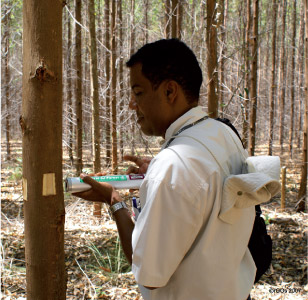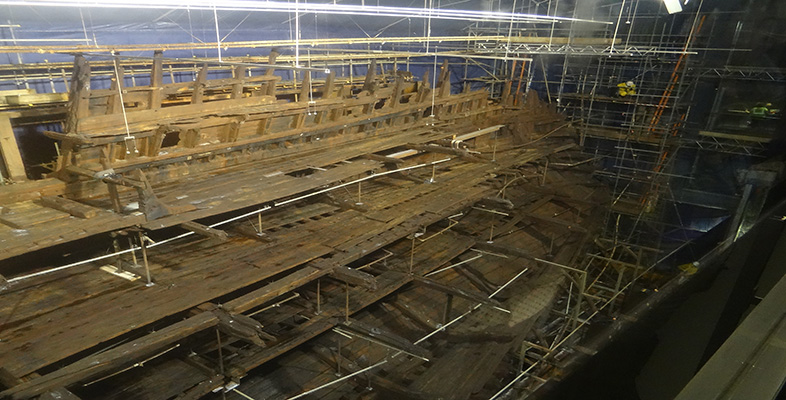5.1 Assessing the moisture content of wood
Dry wood is usually sampled by coring, similar to coring an apple. However, because the Mary Rose's timbers were waterlogged, coring proved difficult. Instead, an instrument called a pilodyn was used (Clarke and Squirrell, 1985). This can directly determine the density and strength of wood without the need to extract samples.
Pilodyns were developed to assess the extent of decay of wooden utility poles, such as telegraph poles, and have since been used for railway sleepers, trees and architectural timbers. A pilodyn uses a spring of known tension to fire a 40 mm-long pin into the wood (Figure 8). Springs are rated according to the energy they impart on the pin, for example pins used for Mary Rose timbers were rated at 2 and 6 joules. When the pin is fired into the wood, the depth it penetrates, in millimetres, is read from a scale. The depth of penetration depends on the rating of the spring used and the strength of the cellulose and lignin, which is governed by its moisture content; a depth of penetration greater than 40 mm is considered to be characteristic of waterlogged wood.

It is interesting to note here that, with some modifications, divers were able to use pilodyns to assess the moisture content of the ship's timbers even before the salvage. The results from the underwater analysis of oak timbers from the Mary Rose are shown in Table 2. Note that the depth of penetration is greater at the ends of the beams (20-40 cm along). These parts of the beams were in contact with the ship's hull, the exterior part of which were likely to be more exposed than the ship's interior. Surprisingly, the extent of waterlogging did not decrease progressively to the interior of the beam.
Look at Table 2. Do the timbers show a progressive alteration from interior to exterior?
No, there is no trend of increasing degradation from interior to exterior. Instead, degradation was patchy, with highly degraded material beside better preserved material.
| Distance along timber/cm | Depth of penetration/mm | |||||
|---|---|---|---|---|---|---|
| Beam 1 | Beam 2 | Beam 3 | ||||
| From port | From starboard | From port | From starboard | From port | From starboard | |
| 20 | 46.5 | 32.0 | 20.5 | 24.5 | 32 | 58.4 |
| 40 | 17.5 | 26.5 | 14.5 | 29 | 32 | 26.5 |
| 60 | 14.5 | 17.5 | 11.5 | 19 | 17.5 | 17.5 |
| 80 | 14.5 | 17.5 | 14.5 | 20.5 | 17.5 | 14.5 |
| 100 | 14.5 | 14.5 | 14.5 | 23.5 | 17.5 | 17.5 |
| 120 | 14.5 | 17.5 | 14.5 | 14.5 | 17.5 | 17.5 |
| 140 | 23.5 | 20.5 | 17.5 | 14.5 | 17.5 | 14.5 |
| 160 | 23.5 | 20.5 | 14.5 | 14.5 | 17.5 | 17.5 |
| 180 | 17.5 | 20.5 | 14.5 | 14.5 | 14.5 | 17.5 |
| 200 | 17.5 | 17.5 | 17.5 | 17.5 | 17.5 | 17.5 |
The results of the underwater pilodyn analyses were complemented by traditional moisture-content analyses (Squirrell and Clarke, 1987), similar to those used to assess the water content of food. Cubes of wood measuring 1 cm were cut from the timbers (oak, poplar and pine), weighed, and dried in an oven for 48 hours. After drying, they were reweighed, the mass difference being considered to represent the moisture lost. Moisture content was expressed as a percentage of the total mass of the samples when fully dried. The results of these studies supported the pilodyn results to show that the extent of waterlogging was uneven through the ship's timbers.
